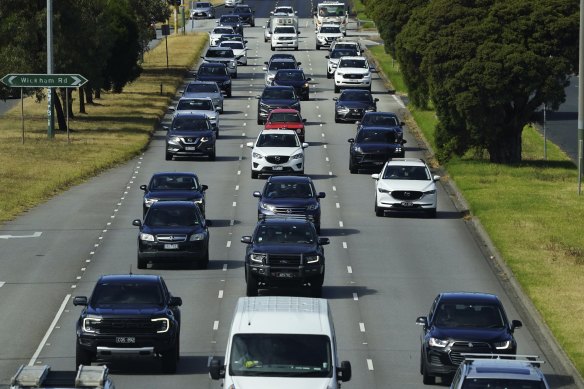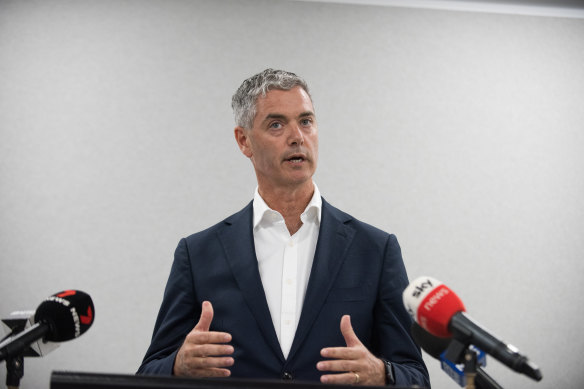By Christopher Harris and Max Maddison
Drivers in NSW will be tracked by point-to-point speed cameras in a bid to catch motorists exceeding limits as the government moves to reduce the number of people dying in road crashes.
A trial of average speed cameras, to roll out on two deadly stretches of regional roads, is a step towards bringing NSW into line with other states using the technology to police speeding.

No date has been set for the trial.Credit: Luis Enrique Ascui
Average speed cameras measure the time a car travels between two points, taking a photo of vehicles calculated to have travelled too fast and sending owners a fine.
So far this year, 227 people have died in NSW road crashes. Speeding is the biggest factor, having contributed to 41 per cent of fatalities in the past decade. Regional crashes account for about two-thirds of road deaths.
One trial location will be on a 15-kilometre stretch of the Pacific Highway between Kew and Lake Innes near Port Macquarie. The other will be in the Riverina, along 16 kilometres of the Hume Highway between Coolac and Gundagai.
Heavy vehicles in NSW are already tracked by average speed cameras and legislation will be required to start the trial or make any permanent change. There is no firm start date for the 60-day trial.
Offending motorists will get a warning letter rather than a fine or losing demerit points during the trial.

Roads Minister John Graham said the UK, Norway, Italy and the Netherlands found average speed cameras to be effective.Credit: Flavio Brancaleone
At a press conference in the Hunter Valley on Sunday, Roads Minister John Graham noted NSW was the sole jurisdiction in the world restricting use of average speed cameras to heavy vehicles. Evidence from use of the the technology in other countries was impressive, he said.
As the government needs to amend existing legislation to begin the trial, he rejected the Coalition’s argument that the move to switch on average speed cameras was simply a cash grab, saying any revenue eventually raised would continue being returned to funding road safety research.
Regional Roads Minister Jenny Aitchison said there was “strong community support” for the implementation of average speed cameras for passenger vehicles.
She said was astounded by the Nationals’ decision to oppose the trial, and had hoped the shift would receive bipartisan support. “We are throwing everything we’ve got at it, and if a trial like this saves lives, well, I’m sleeping happy at night,” she said.
NRMA spokesman Peter Khoury said the motoring group would work with the government to review the speeding data at the trial locations to ensure it effectively changed driver behaviour.
“We don’t just want to fine people, we want to slow them down... It is a fact-finding mission to see if these cameras work,” he said.
However, Khoury said while the cameras might be a cost-effective way for the government to detect and reduce speeding, there was no substitute for having more police on roads and federal and state government investment in improving the road network, particularly outside Sydney.
“You’ve got to make the police the tip of the spear, enforcement which costs money is crucial.
“Police are not only able to target speeding, they also stop people drinking, taking drugs while driving and driving with fatigue,” he said.
The annual road toll fell during pandemic lockdowns but increased by 25 per cent in 2023 with 351 deaths recorded that year.
The biggest increases in deaths have been in metropolitan areas of NSW. There were 101 deaths around Sydney in the 12 months to July 2024, a 33 per cent increase on the annual fatality rate in the previous three years. By comparison, fatal crashes in non-urban parts of regional NSW increased 20 per cent to 142 deaths over the same period.
Opposition spokesman for regional transport and road Dave Layzell reiterated that the move was a cash grab by the government.
“This announcement is a narrow approach to road safety that looks to raise revenue from regional residents,” he said.
“Every life lost on our roads is one too many and we will always support genuine investment in road safety measures, but this very serious issue should not be used as a cash grab,” he said.
“It needs to look for a broader statewide approach to tackle the road toll, instead of picking our pockets to redirect money back to Sydney.”
Transport for NSW’s Centre for Road Safety data shows that in the 25 regional locations where average speed cameras are used on trucks, there has been a 53 per cent reduction in fatalities from crashes involving heavy vehicles.
A 2015 study in Norway found average speed cameras cut deaths and serious injuries in crashes by 49 per cent. A UK study in 2016 reported they reduced deaths and serious injuries by 36 per cent.
The trial is expected to start in mid-2025.